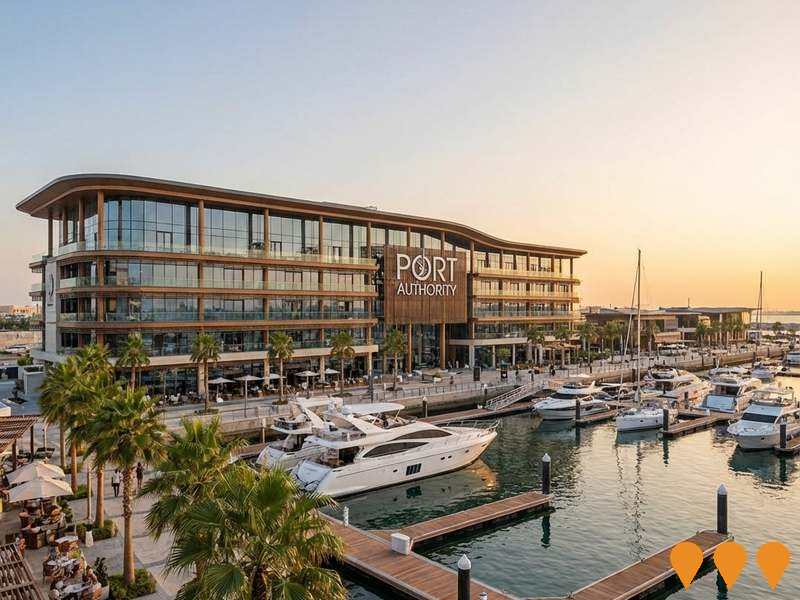Chart Color Schemes
est. as @ -- *
ABS ERP | -- people | --
2021 Census | -- people
Sales Activity
Curious about local property values? Filter the chart to assess the volume and appreciation (including resales) trends and regional comparisons, or scroll to the map below view this information at an individual property level.
Find a Recent Sale
Sales Detail
Population
Daly is positioned among the lower quartile of areas assessed nationally for population growth based on AreaSearch's assessment of recent, and medium term trends
Daly's population was around 2,185 as of August 2025. This reflected an increase of 295 people from the 2021 Census figure of 1,890 people. The change was inferred from the estimated resident population of 2,185 in June 2024 and two additional validated new addresses since the Census date. This resulted in a density ratio of 0.10 persons per square kilometer. Daly's growth rate of 15.6% since the 2021 Census exceeded both the national average (8.6%) and the state, positioning it as a regional growth leader. Natural growth contributed approximately 60.5% of overall population gains during recent periods.
AreaSearch adopted ABS/Geoscience Australia projections for each SA2 area, released in 2024 with a base year of 2022. For areas not covered by this data and post-2032 growth estimation, AreaSearch applied age cohort-based growth rates from the ABS's Greater Capital Region projections (released in 2023, based on 2022 data). Future demographic trends suggest a population increase just below the median of regional areas across Australia. By 2041, Daly is expected to grow by 272 persons, recording a total gain of 12.4% over the 17 years.
Frequently Asked Questions - Population
Development
Residential development activity is lower than average in Daly according to AreaSearch's national comparison of local real estate markets
Daly has had minimal residential development activity in recent years. From 2015 to 2019 inclusive, there were only eight dwelling approvals annually on average. This low level of development is typical of rural areas where housing needs are modest and construction activity is limited by local demand and infrastructure capacity.
It should be noted that with such a small number of approvals, individual projects can significantly impact annual growth and relativity statistics. Daly has shown significantly less construction activity compared to the Rest of NT during this period. The development pattern in Daly is also well below national averages. Furthermore, recent building activity has consisted entirely of detached dwellings, aligning with rural living preferences for space and privacy.
This favours detached housing more than current patterns suggest (83.0% at Census), indicating ongoing robust demand for family homes despite increasing density pressures. Future projections indicate that Daly is expected to add 272 residents by 2041. If current development rates continue, housing supply may not keep pace with population growth, potentially increasing competition among buyers and supporting stronger price growth in the future.
Frequently Asked Questions - Development
Infrastructure
Daly has limited levels of nearby infrastructure activity, ranking in the 15thth percentile nationally
Changes to local infrastructure significantly impact an area's performance. AreaSearch has identified nine projects likely to affect the region. Key projects include Desert Springs Octopus Renewable Energy Program, Adelaide River Off-Stream Water Storage, Australia-Asia PowerLink (AAPowerLink), and Katherine Solar Farm (ENI). The following list details those most relevant.
Professional plan users can use the search below to filter and access additional projects.
INFRASTRUCTURE SEARCH
 Denotes AI-based impression for illustrative purposes only, not to be taken as definitive under any circumstances. Please follow links and conduct other investigations from the project's source for actual imagery. Developers and project owners wishing us to use original imagery please Contact Us and we will do so.
Denotes AI-based impression for illustrative purposes only, not to be taken as definitive under any circumstances. Please follow links and conduct other investigations from the project's source for actual imagery. Developers and project owners wishing us to use original imagery please Contact Us and we will do so.
Frequently Asked Questions - Infrastructure
Australia-Asia PowerLink (AAPowerLink)
The world's largest renewable energy infrastructure project, comprising a 17-20GW solar farm and 36-42GWh battery storage in the Barkly Region, connected via HVDC transmission to Darwin and Singapore. The project received Commonwealth environmental approval in August 2024. It aims to supply up to 4GW of green electricity to Darwin industrial customers and export power to Singapore.

Enabling Digital Health Services for Regional and Remote Australia
National initiative to expand and improve digital health access for people in regional and remote Australia. Focus areas include enabling telehealth and virtual care, upgrading clinical systems and connectivity, supporting secure information exchange, and building workforce capability in digital health, aligned with the Australian Government's Digital Health Blueprint and Action Plan 2023-2033.
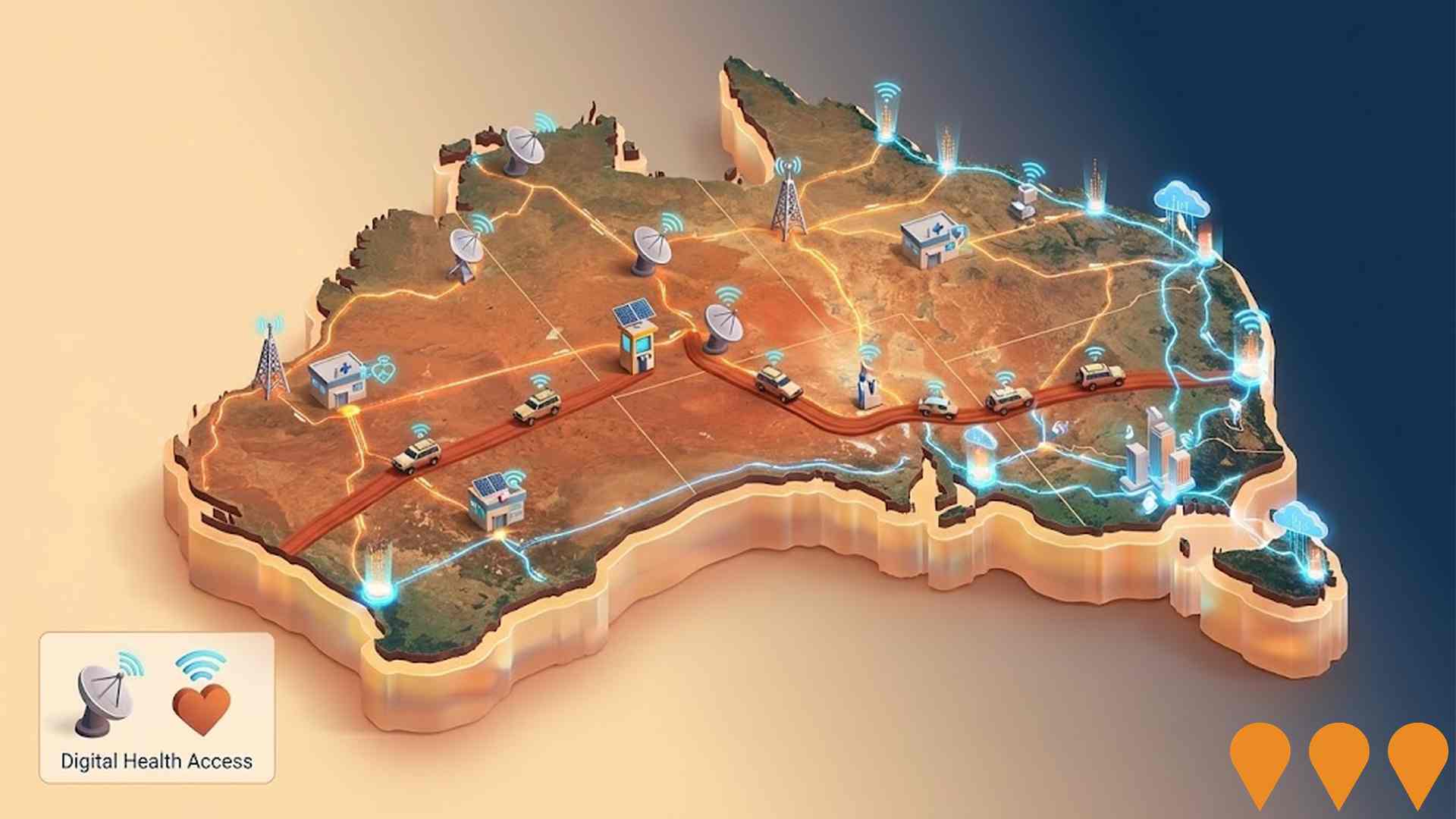
Desert Springs Octopus Renewable Energy Program
Majority Indigenous-owned developer pursuing a near-term pipeline of grid-connected solar and battery projects along the Darwin-Katherine Electricity System, with potential to expand into wind and green hydrogen. Partnership includes Octopus Australia with Larrakia Nation and Jawoyn Association to deliver utility-scale renewable energy and community benefit sharing.

Katherine Solar Farm (ENI)
34MW solar farm with 6MW battery energy storage system, currently the largest photovoltaic plant in Northern Territory. Features innovative cloud coverage prediction technology and avoids 63,000 tonnes of CO2 emissions annually. Contributes significantly to NT's 50% renewable energy target by 2030.
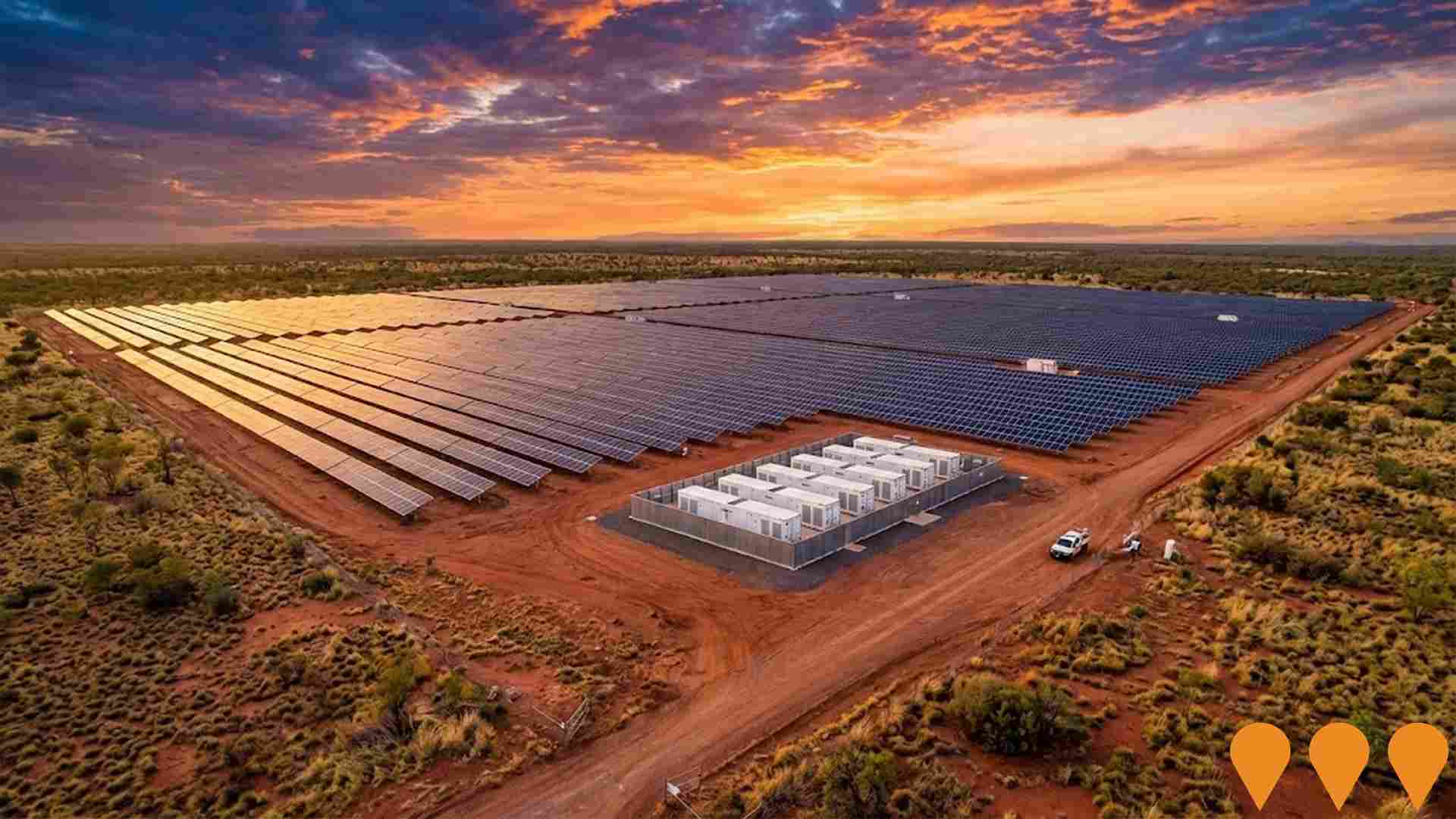
Katherine Logistics and Agribusiness Hub
Large-scale industrial subdivision and intermodal hub adjacent to rail and highway links to support storage, processing and freight for agriculture and resources in the Big Rivers region. Current works focus on enabling infrastructure including water supply and headworks.
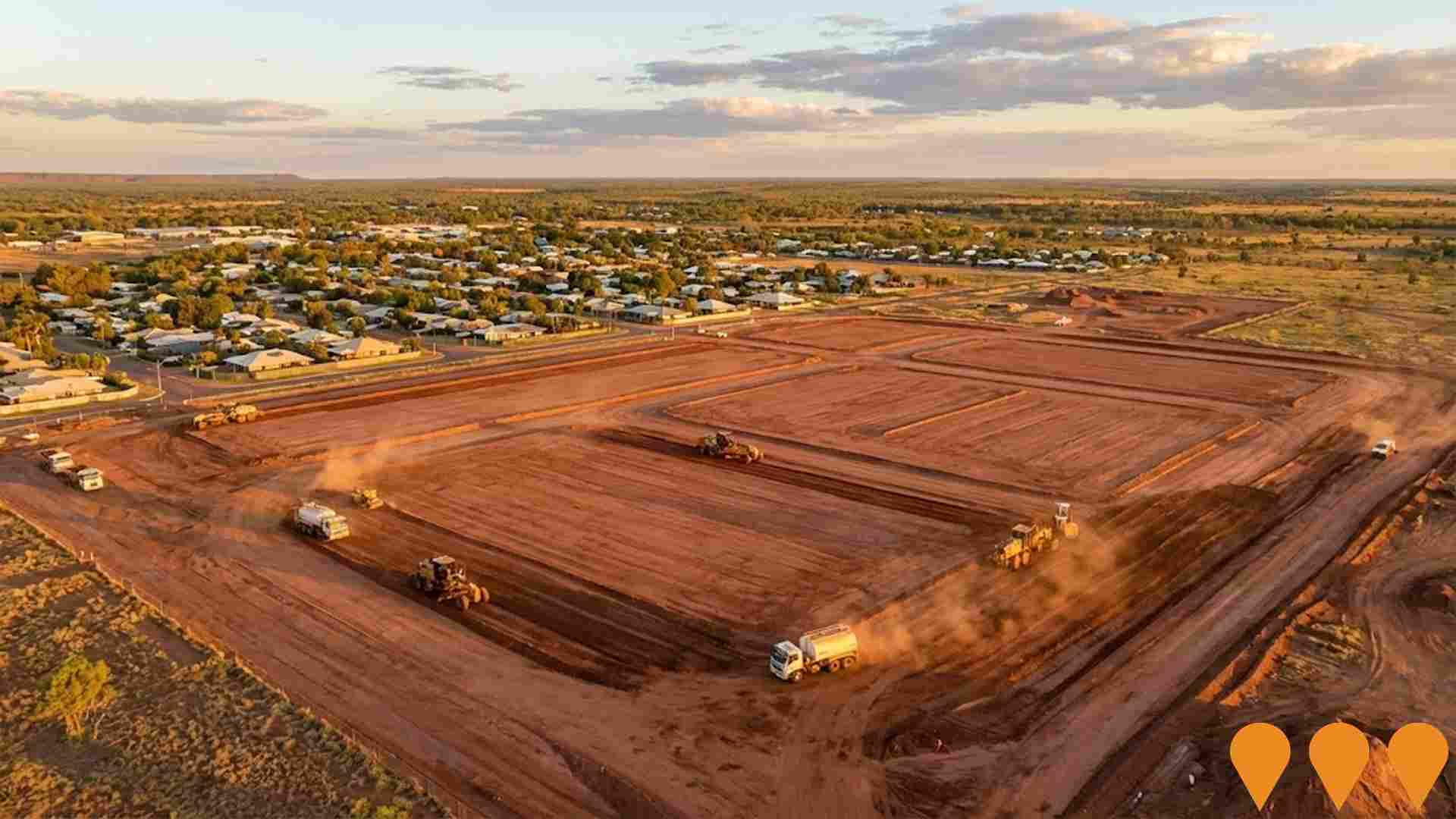
RAAF Base Tindal Redevelopment
Major upgrade program at RAAF Base Tindal near Katherine, NT, to enhance airbase capacity and resilience. Scope includes runway and taxiway upgrades, new air movements terminal and parking apron, expanded fuel storage, power-water-sewer upgrades, new central emergency power station, visiting squadron and security facilities, and new live-in accommodation for personnel. Works are being delivered under Stage 6 Redevelopment and the US Force Posture Initiatives, managed by Lendlease with packages led by contractors including BMD and Nova-Nacap.
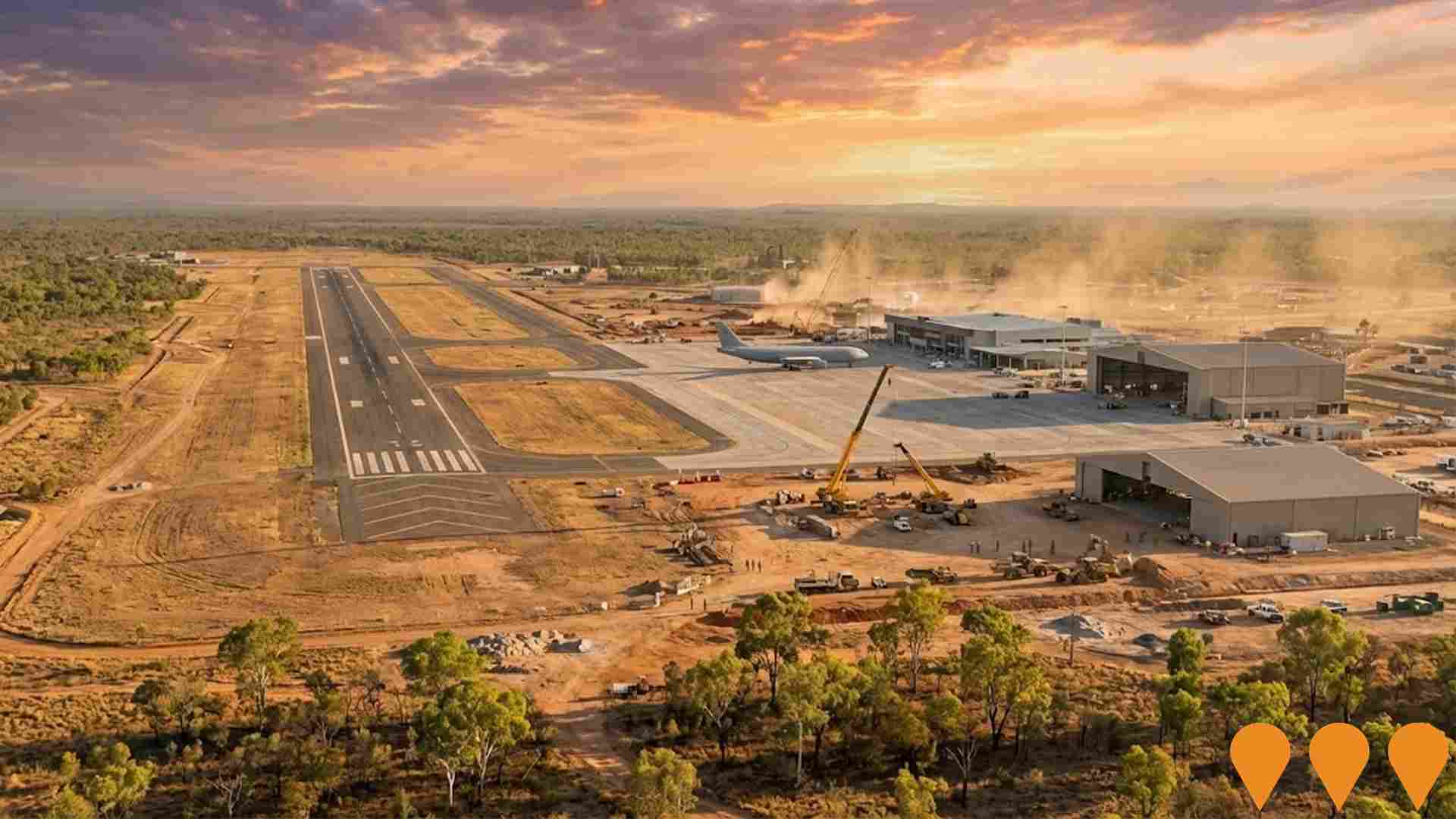
Supporting Growth in Katherine East (Katherine East Residential Estate)
NT Government enabling works to service six superlot parcels outside the flood zone in Katherine East. The program delivers new enabling streets, headworks, stormwater upgrades and a neighbourhood centre site, creating potential for about 300 future residential lots and local retail and community uses. Budget 2024 allocated $16m for a sewer pump station and network plus further subdivision works. Co-funded by NT and Australian Governments.

Adelaide River Off-Stream Water Storage
The AROWS project, aimed at enhancing Darwin's water supply, plans to annually add up to 67.5 gigalitres of water. It includes creating a reservoir, laying pipelines, and upgrading treatment plants over 7-10 years. The project complements broader water security efforts in the Darwin region, including upgrades to Manton Dam.

Employment
Employment conditions in Daly face significant challenges, ranking among the bottom 10% of areas assessed nationally
Daly's workforce is balanced across white and blue-collar jobs, with essential services well represented. The unemployment rate in June 2025 was 10.3%.
There were 801 residents employed at this time, which was 4.4% higher than the Rest of NT's rate of 5.9%. Workforce participation in Daly lagged significantly at 37.9%, compared to the Rest of NT's 50.7%. Key industries for employment among residents were agriculture, forestry & fishing, education & training, and public administration & safety. Agriculture, forestry & fishing showed notable concentration with employment levels at 4.0 times the regional average.
Health care & social assistance had limited presence with 8.2% employment compared to the regional average of 18.8%. The area appears to offer limited local employment opportunities, as indicated by the Census working population count vs resident population. Between June 2024 and June 2025, Daly's labour force decreased by 1.8%, with employment decreasing by 1.5%, resulting in a fall of 0.3 percentage points in unemployment rate. In contrast, Rest of NT saw employment contract by 1.7% and the labour force fell by 1.8%, with marginal changes in unemployment. Jobs and Skills Australia's national employment forecasts from May 2025 suggest potential future demand within Daly. These projections estimate national employment growth at 6.6% over five years and 13.7% over ten years, but growth rates vary significantly between industry sectors. Applying these projections to Daly's employment mix suggests local growth of approximately 5.2% over five years and 11.4% over ten years.
Frequently Asked Questions - Employment
Income
Income metrics place the area in the bottom 10% of locations nationally according to AreaSearch analysis
According to AreaSearch's aggregation of ATO data released for financial year 2022, Daly had a median income among taxpayers of $39,590 and an average level of $52,836. This is lower than the national average, which was $51,655 in Rest of NT. Based on Wage Price Index growth of 12.01% since financial year 2022, estimated median income as of September 2025 would be approximately $44,345 and average income $59,182. According to the 2021 Census, household, family and personal incomes in Daly fall between the 1st and 12th percentiles nationally. Income analysis shows that the largest segment comprises 30.0% earning $1,500 - $2,999 weekly (655 residents). Housing costs are modest with 93.1% of income retained, but total disposable income ranks at just the 22nd percentile nationally.
Frequently Asked Questions - Income
Housing
Daly is characterized by a predominantly suburban housing profile, with above-average rates of outright home ownership
Daly's housing structure, as per the latest Census, consisted of 82.8% houses and 17.3% other dwellings (semi-detached, apartments, 'other' dwellings). In comparison, Non-Metro NT had 83.6% houses and 16.4% other dwellings. Home ownership in Daly was higher at 21.4%, with mortgaged dwellings at 9.5% and rented ones at 69.1%. The median monthly mortgage repayment in Daly was $1,181, lower than Non-Metro NT's average of $1,346. The median weekly rent in Daly was $80, the same as Non-Metro NT's figure. Nationally, Daly's mortgage repayments were significantly lower than the Australian average of $1,863, and rents were substantially below the national figure of $375.
Frequently Asked Questions - Housing
Household Composition
Daly features high concentrations of group households, with a higher-than-average median household size
Family households account for 72.1% of all households, including 38.6% couples with children, 15.6% couples without children, and 16.4% single parent families. Non-family households constitute the remaining 27.9%, with lone person households at 23.3% and group households comprising 4.1%. The median household size is 3.6 people, which is larger than the Rest of NT average of 3.5.
Frequently Asked Questions - Households
Local Schools & Education
Daly faces educational challenges, with performance metrics placing it in the bottom quartile of areas assessed nationally
The area's university qualification rate is 8.8%, significantly lower than the Australian average of 30.4%. This disparity presents both a challenge and an opportunity for targeted educational initiatives. Bachelor degrees are most common at 5.8%, followed by postgraduate qualifications (1.8%) and graduate diplomas (1.2%). Vocational credentials are prevalent, with 31.4% of residents aged 15+ holding them - advanced diplomas account for 6.0% while certificates make up 25.4%.
Educational participation is high at 34.7%, including 22.9% in primary education, 7.5% in secondary education, and 0.8% pursuing tertiary education. Nine schools operate within Daly, educating approximately 330 students. The educational mix includes 2 primary schools and 7 K-12 schools.
Frequently Asked Questions - Education
Schools Detail
Nearby Services & Amenities
Transport
No public transport data available for this catchment area.
Frequently Asked Questions - Transport
Transport Stops Detail
Health
Daly's residents boast exceedingly positive health performance metrics with very low prevalence of common health conditions across all age groups
Health outcomes data shows excellent results across Daly, with very low prevalence of common health conditions across all age groups. Private health cover rate is approximately 47% of the total population (~1,020 people), lower than the national average of 55.3%.
Diabetes and asthma are the most common medical conditions in the area, affecting 4.8 and 4.3% of residents respectively. A total of 82.4% of residents declare themselves completely clear of medical ailments, higher than the Rest of NT's figure of 78.5%. The area has an 8.4% senior population (183 people), with seniors' health outcomes broadly in line with those of the general population.
Frequently Asked Questions - Health
Cultural Diversity
The level of cultural diversity witnessed in Daly was found to be above average when compared nationally for a number of language and cultural background related metrics
Daly's population shows above-average cultural diversity, with 5.4% born overseas and 64.9% speaking a language other than English at home. Christianity is the predominant religion in Daly, accounting for 65.5%. The 'Other' category comprises 4.3%, higher than the Rest of NT's 6.9%.
The top three ancestral groups are Australian Aboriginal (67.6%), Australian (9.7%), and English (8.4%). Notably, French (0.6% vs regional 0.2%), Vietnamese (0.3% vs 0.7%) and Chinese (1.6% vs 0.7%) populations diverge from their respective regional representations.
Frequently Asked Questions - Diversity
Age
Daly hosts a very young demographic, ranking in the bottom 10% of areas nationwide
At 28 years, Daly's median age is marginally below the Rest of NT average of 31 and substantially under Australia's 38 years. Relative to Rest of NT, Daly has a higher concentration of 5 - 14 residents at 17.3%, but fewer 45 - 54 year-olds at 9.4%. This 5 - 14 concentration is well above the national average of 12.2%. Between the 2021 Census and present, the 35 to 44 age group has grown from 11.8% to 14.8%, while the 75 to 84 cohort increased from 1.6% to 2.8%. Conversely, the 5 to 14 cohort has declined from 19.0% to 17.3%, and the 15 to 24 group dropped from 17.6% to 16.6%. Looking ahead to 2041, demographic projections reveal significant shifts in Daly's age structure. Leading this shift, the 35 to 44 group is expected to grow by 30%, reaching 420 from 322. Meanwhile, numbers in the 5 to 14 age range are projected to fall by 49%.
